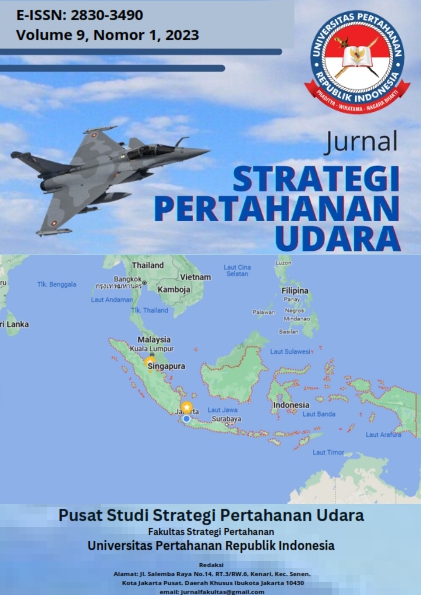INTELLIGENCE INTERCONNECT COMMUNICATION SYSTEM (IICS) PADA NETWORK CENTRIC WARFARE OPERASI UDARA
DOI:
https://doi.org/10.33172/jspu.v9i1.8213Abstract
The Indonesian Air Force (IAF) intelligence interconnect communication system (IICS) is a communication device which can deliver information/instructions/ commands in a voice that the IAF chairman addressed to the ground units to conduct an IAF operation mission. The development of the future war has applied the network concept or often called network warfare. However, the IAF has not fully used its advantages optimally. The objective of the study is to describe and analyze the advantages of IICS that can be used as the first step in the development and application of NCW IAF communication systems. The study uses descriptive qualitative methods that describe the use of IICS in various air operations and the factors that affect IICS which is analysed by using the system integration theory of communication, NCW, Information Superiority, Internet of Things and Interoperability. Data is collected by conducting interviews with the experts of IICS and NCW. Studies have shown that IICS can integrate some communications equipment into a new system and assist deliver information in real-time and forward command information to generate destruction on a predetermined target. Furthermore, IICS also provide strategic information for the main weaponry system by using the information selected by the commander. Moreover, it can be developed in a larger network that enhances awareness (Situational Awareness) in implementing movement or action. If the IICS has been done consistently and thoughtfully, it will increase the effectiveness of accomplishing the operation missions and exercisesReferences
Akbar, N. (2019). InfoPublik - Tak Lagi Konvensional, Panglima Paparkan Metode Peperangan Network Centric Warfare.
Alberts, D., Garstka, J., & Stein, F. (2000). Network Centric Warfare: Developing and Leveraging Information Superiority. In Naval War College Review (Vol. 53, Issue 2). https://doi.org/10.21236/ada406255
Cebrowski A K. (2005). The Implementation of Network-Centric Warfare. Office of Force Transformation, 1–82.
Diskomlekau. (2018). Markas besar angkatan udara dinas komunikasi dan elektronika. In Prosedur Tetap.
Dispenau. (2015). Visi dan Misi KPI. In Kpi.Go.Od. http://www.kpi.go.id/index.php/id/visi-dan-misi
Groh, J. L. (2008). Network Centric Warfare Leveraging The Power of Information. Strategie Studies Institute, US Army War Collage, 323–338.
Heniarti. (2009). Reformasi Intelijen. Halaman Utama Pikiran Rakyat, Selasa 8 September 2009.
Litvaitis, A. (2008). Baltic Security & Defence Review Challenges of Implementation of the Network Centric Warfare Tenets in Coalition Environment. 10, 143–170.
Luddy, J. (2005). the Challenge Network-Centric Warfare (Issue February).
Mabesau. (2019). 5. Nsk Ranc Renstra TNI AU 2020-2024.
Pranata, Y. A., Fibriani, I., & Utomo, S. B. (2016). Analisis Optimasi Kinerja Quality of Service Pada Layanan Komunikasi Data Menggunakan Ns-2 Di Pt. Pln (Persero) Jember. Sinergi, 20(2), 149. https://doi.org/10.22441/sinergi.2016.2.009

